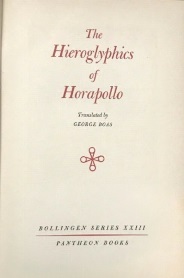| Main » Ad Board » ДРЕВЕН ЕГИПЕТ И АФРИКА » Език и писменост |
| 13.03.2022, 15:39 | |
Йероглифика е късноантичен трактат за древноегипетските йероглифи, приписван на Хораполон - един от последните жреци на традиционната египетска религия, живял през V в. Съчинението е съхранено в гръцки препис от XV в. открит на о. Андрос и пренесен след това на Запад. Произведението представя йероглифите като многопластови сакрални символи, носещи богат алегоричен символизъм и като такова е във висша степен резултат от фантазията на елинистически интерпретатори, но въпреки това все пак разкрива известна реална запознатост с тази прастара египетска писменост. То оказва огромно влияние върху елитарната култура на Ренесанса, а преди откритията на Шамполион е единственият източник на някакви сведения за йероглифите. - на английски език, от Google Drive, формат PDF. Сваляне с ляв бутон (downloading by left button) от страницата на предоставящия сървър, после през бутона стрелка надолу/after by down arrow button. - на английски език, от Google Drive, формат EPUB. Сваляне с ляв бутон (downloading by left button) от страницата на предоставящия сървър, после през бутона стрелка надолу/after by down arrow button. - на английски език, от Google Drive, формат AZW3. Сваляне с ляв бутон (downloading by left button) от страницата на предоставящия сървър, после през бутона стрелка надолу/after by down arrow button. АЛТЕРНАТИВНИ ЛИНКОВЕ / ALTERNATIVE LINKS: - на английски език, от Google Drive, формат PDF. Сваляне с ляв бутон (downloading by left button) от страницата на предоставящия сървър, после през бутона стрелка надолу/after by down arrow button. - на английски език, от Google Drive, формат EPUB. Сваляне с ляв бутон (downloading by left button) от страницата на предоставящия сървър, после през бутона стрелка надолу/after by down arrow button. - на английски език, от Google Drive, формат AZW3. Сваляне с ляв бутон (downloading by left button) от страницата на предоставящия сървър, после през бутона стрелка надолу/after by down arrow button.
| |
| Views: 532 | Placed till: 13.04.2022 | Rating: 0.0/0 | |

